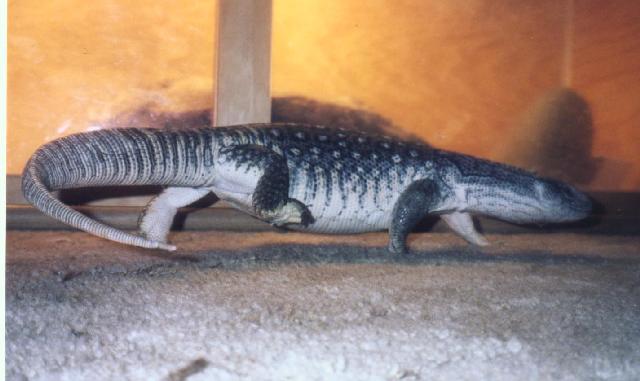
Keeping Savanna Monitors in Captivity
Savanna monitors are the most popular pet monitor in today's market because they are cheap, freqently become tame, and do not reach unmanageable sizes. However, savannas are misunderstood lizards, and are all too often kept in an inapropriate environment.
In captivity, many savanna monitors are overfed, kept too cold, not allowed to exercise, and become lethargic and then obese. This is unhealthy. Due to their higher metabolisms, savanna monitors should be fed more than a similar sized snake, but their diet should be carefully regulated to avoid becoming fat. A savanna will still be eager to eat even when it has already had more than is healthy. In the wild, they need to build up fat stores in a period of three months or so of plenty before a prolonged fast of eight to nine months when food is only scarcely available, if it is available at all. In captivity, this is not necessary, but the monitor thinks it still has to eat as much as it can to pack away fat stores for a lean period that will never come. In its eagerness to feed, many owners give in to their pets cravings and let it have far more food than is good for it.
A healthy savanna monitor should be an inquisitive, curious creature that actively explores its environment. As befits such an active reptile, of course, a savanna should have plenty of space to roam. For a small adult, 1 square meter of floor space might just be barely adequate, 2 square meters would be much better. An ambient temperature of 25 to 30 degrees Celcius and a basking spot of 45+ degrees celcius large enough to cover the monitor's entire body will allow the savanna to warm up or cool off to its preferred active body temperature of 34 to 37 degrees. Basking heat is best provided by visible radient light, as might be produced by a pair of 100 watt incandescent bulbs (juveniles could get by with a single 100 watt bulb).
A hide box or other such retreat should be constructed for when the savanna is sleepy, tired, or just feeling antisocial. Putting some moisture retaining substance, such as soil, potting moss, or orchid bark in the hide box will allow the savanna to conserve moisture as it would in the wild by hiding in its burrow.
The correct humidity is important for keeping savannas. In addition to a moist hide box, savannas are more active when the outside humidity is up, simulating the natural rainy season in the lands that they live. Savannas are active in the rainy season, when food is abundant, and inactive when it gets too dry. Water should be accessible at all times, of course, preferably in a dish big enough to soak in.
A loose substrate is best because it allows your pet to dig, something that savannas love. Whatever yopu use should hold a burrow and humidity. Good soil, when you can get it, is best. Cypress mulch or coconut pith mulch can do in a pinch.
When it is fed, a mix of whole food items can make up the bulk of its diet. Savannas only rarely eat vertebrate prey in the wild. Insects and other invertebrates are probably thus preferred over rodents as the primary diet of the savanna monitor. Crickets, mealworms, giant cockroaches, earthworms, and snails are all relished by these lizards. The occasional mouse will not hurt, of course. Some keepers are successful with a diet of primarily rodents, cat food, or some similar diet. There is nothing wrong with this so long as the monitor is healthy, but such diets are typically higher in fat than an invertebrate diet, and so greater care must be taken to ensure that the savanna monitor does not overfeed.
Other than their feeding requirements, savannas can be kept in a very similar fashion to argus monitors.
For photos of one of my savanna monitors, click here.